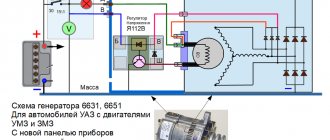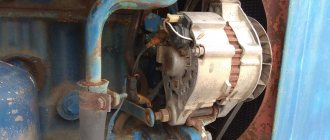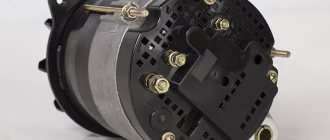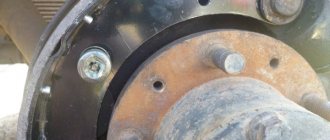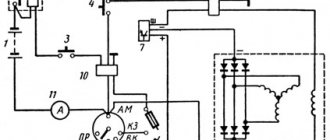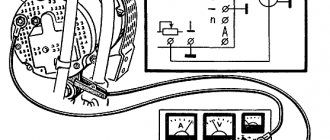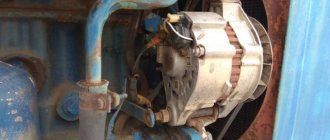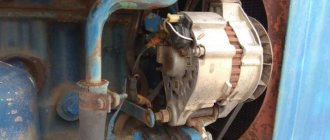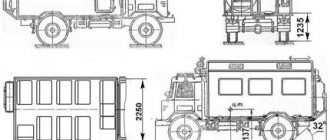The shaft is steel, on its corrugated surface, a steel bushing, pole pieces and slip rings are rigidly fixed by pressing.
Features of the generator When using, adhere to the following rules: 2.
The principle of operation of the generator set G, using the example of its inclusion in the electrical circuit of MAZ vehicles, is shown in Fig. Correct connection of the generator "KAMAZ" Euro 2. Connect generator "KAMAZ" Euro 2.
On the car, the regulator is turned off. The field winding is powered by a direct current source such as a battery. The generator is cooled by continuous ventilation. The ball bearing, located on the shaft on the drive side, is fixed against axial movement. If necessary, verify the serviceability of indicating devices using known good ones.
Current-speed characteristic of the generator Fig. When installing the generator on the engine, you must: 2.
In the first case, it may be a cooling or fuel supply system consisting of diverse elements. GENERATOR AND RELAY 702 FOR INDICATION OF GENERATOR OPERATION
MAZ generator circuit
If the voltage increases or decreases, the regulator accordingly reduces or increases the excitation current and brings the voltage within the desired limits. The presence of permanent magnets ensures reliable self-excitation of the generator when starting, both when working with a battery and without it.
The presence of constant voltage at the output can be used to signal the start of operation of the generator, for which pilot lamps, starter blocking relays, etc. can be connected to it.
On another small-sized ceramic board there are crystal structures of the transistor of the pre-final stage T2, the output transistor T3 and the quenching diode D1. The rectifier unit converts alternating voltage into direct voltage, and when it becomes greater than the battery voltage, the generator will begin to power consumers and charge the battery.
When washing the engine, it is recommended to protect the generator from water. The shaft is steel, on its corrugated surface, a steel bushing, pole pieces and slip rings are rigidly fixed by pressing.
Page 1 of 3 Features of the power supply system of a MAZ car The power supply system for cars consists of two sources: batteries and an alternating current generator set. The YaMZ generator produces current.
The cover on the side of the slip rings is made of aluminum alloy, has ventilation windows and a claw for mounting the generator on the engine. The higher the rotor speed and the lower the load on the generator, the higher the generator voltage.
The rotor is installed in KS9 bearings International designation Repair of generator G 273 Kamaz, MAZ ...
Checking the rotor winding
A common malfunction of a car generator is short-circuiting of the windings. This can happen as a result of a sudden voltage surge, water ingress, brush wear, etc. Since you can check the generator with a multimeter for the integrity of its windings only by gaining full access to them, you will need to dismantle the entire assembly. We will not describe this process, since it differs for different cars. Before checking the removed generator for operability of the rotor winding, it naturally needs to be disassembled.
After removing the rotor, we find slip rings on its shaft. There are only two of them. Having turned on the multimeter in ohmmeter mode, we connect its probes to these rings. The device should produce a resistance within 2-5 Ohms. These are normal indicators for a working rotor. A higher resistance indicates poor contact between the rings. In the opposite case, when the instrument readings approach zero, an interturn short circuit most likely occurs.
How to connect a MAZ generator?
When washing the engine, it is recommended to protect the generator from water. Each phase consists of twelve series-connected coils located on individual poles for a total of 36 poles.
The brush holder also contains a 75 Ohm feed resistance 3, which serves to ensure reliable excitation of the generator set at low engine speeds. Disabling the battery while the power unit is operating reduces the load and leads to a malfunction of the YaMZ generator. Replacement of a failed regulator and brushes must be carried out in a workshop.
If these measurements deviate beyond the required limits, it is necessary to determine and eliminate the malfunction of the vehicle's on-board network. Connection diagram for the MAZ generator Date of publication: The maximum excitation current for which the design elements of the regulator I are designed is 3.3 A.
This is done in order to relieve the load on the VPS contacts, since the current during the initial excitation of the generator can reach 5 A. The generator set is a three-phase twelve-pole synchronous electric machine with a built-in rectifier unit, an interference-suppressing capacitor, a brush holder with a voltage regulator and a system with continuous ventilation. In addition to its direct functions - generating electricity to supply the electrical equipment of a car, there is one more requirement for modern generators - it must not influence or respond to radio waves. The core is made of electrical steel plates, insulated from each other with varnish and connected by welding along the outer surface of the package. And it is required for the ignition system, on-board computer and now for various gadgets, diagnostic and control devices and, of course, for lighting, both signal and household.
Generators and relay regulators for diesel engines. Part 5.
Generators and relay regulators of diesel engines YaMZ-236, YaMZ-238, KamAZ-740
Part 5
Continued. Start watching here: part 1, part 2, part 3, part 4
the G-273 generator set, using the example of its inclusion in the electrical circuit of MAZ vehicles, is shown in Fig. 50. When the mains switch VM and the switch lock VK are turned on (position 1), the generator set is connected to the battery.
0.06 Ohm; R1 = 300 - 400 Ohm; R2 = 300 Ohm; RЗ = 1300 Ohm; R4 = 800 Ohm; R5 = 2000 Ohm; Yaos = 8 kOhm; C1, C2 0.1 µF each; T1 - transistor KT808A; T2 - transistor KT807B; TZ - transistor KT315B; D1 - quenching diode, emitter-base junction of transistor KT808A; D2 and DZ are zener diodes, the emitter-base junction of the KT315 transistor. The arrows show the excitation current Ib when transistor T1 is open; B and K - marking of terminals on VM and RP devices; 0 — “Off”, 1 — “Device”, 2 — “Starter”, 3 — “Parking, receiver”
Current paths:
— current divider: “+” AB, ammeter A, VK, terminals B of the generator and regulator, resistors R4 and RZ of the divider, “ground”;
— control current of transistor T1: “+” AB, terminals B of the generator and regulators, resistor R5, base-emitter junction T2, base-emitter junction T1, resistor R, “ground”;
When the generator voltage increases above the voltage regulator setting (U g > U pH), the zener diodes D2 and DZ open, the base current of transistor T3 appears, transistor T3 opens, and transistors T2 and T1 are closed, and the excitation current decreases. When the excitation current decreases, the generator voltage drops, the zener diodes D2 and DZ are closed again, the circuit returns to its original position, and the generator voltage begins to rise again. The process is repeated with high frequency, similar to the operation of a vibration controller.
Maintaining the regulator comes down to periodically checking the level of the regulated voltage and checking the reliability of contact between the flat terminals “B”, “W”, “C” and “D” (see Fig. 49) and the corresponding brush holder tires. Replacement of a failed regulator and brushes must be carried out in a workshop. When operating automobile alternators in a vehicle, the following is prohibited:
— starting the engine with the positive wire of the generator disconnected (dangerously high voltage on the rectifier);
— connecting the battery to the network with reverse polarity (failure of the generator and voltage regulator);
— operation of the generator with a voltage regulator when the battery is disconnected;
— check the serviceability of the generator for a “spark”; connect clamp “W” and clamps “B” of the brush holder and “+” of the generator (instant failure of the regulator);
— check the serviceability of the electrical circuit from a current source with a voltage of more than 36 V, if the generator with the regulator is not disconnected from the circuit.
Care must be taken to ensure that water and oil do not come into contact with the generator and regulator.
Source
Tips for use
The MAZ car generator must be checked periodically. When using, adhere to the following rules:
- Do not check the condition of the MAZ generator circuits with a light bulb or megohmmeters with a voltage of more than 26 V;
- Do not inspect the unit by shorting the terminals;
- Do not disconnect the wires from the terminal, as well as the battery, while the unit is running.
According to the MAZ generator connection diagram, polarity is strictly observed. Belt tension is checked only after stopping the engine and battery.
Be careful when washing your car. Therefore, make sure that water does not get into the part. Otherwise, over time, breakdowns will occur, which will lead to the repair of the spare part.
The best prices
When checking the generator on a car, reconnect the wires and connect instruments for testing with the mains switch turned off.
The zener diode does not pass current through itself at a voltage below the stabilization voltage and breaks through, i.e. And while this state of affairs persists, the need for a car generator does not disappear - too many elements of the car depend on the electricity that this device generates.
Voltage regulator type 51 This is done in order to relieve the load on the VPS contacts, since the current during the initial excitation of the generator can reach 5 A.
Therefore, the presence of a lock prevents damage to the spark plugs of the electric torch device. As the rotor speed increases, the generator voltage can reach a value dangerous for the receivers. Therefore, make sure that water does not get into the part. If necessary, clean the wire connection points and tighten the contact parts of the generator and relay regulator.
MAZ car power supply system
The generator housing is the negative terminal and is connected to the ground of the machine. A correctly tensioned generator drive belt should have a deflection of 10-15 mm from a force of 3 kg applied to the middle of the belt branch.
The excitation winding of the generator is connected to the on-board network and then the generator operates as described above, see. The ends of the excitation winding are soldered to slip rings located on the insulating sleeve. Otherwise, over time, breakdowns will occur, which will lead to the repair of the spare part. Generator set G replaces generators G and G with corresponding voltage regulators. The generator is excited by current from an independent source - batteries.
The regulator is an electronic device, closed with a lid and filled with a special sealant. Disassembly is carried out in the following order: 1. Repair of the MAZ generator, unscrew the two screws securing the brush holder 3 cm. However, today we want to look at the connection diagram of the devices and give some tips on operation. If necessary, we can send the purchase to any region, we work with cash and non-cash forms of payment, and we arrange deferments.
This was done in order to relieve the load on the VPS contacts, since the current during the initial excitation of the generator can reach 5 A. When the excitation current decreases, the generator voltage drops, the zener diodes D2 and DZ are closed again, the circuit goes to its original position, and the generator voltage begins to rise again. Check the installation after 50 runs and at each maintenance. Purpose of operation and design of the generator
How to connect a MAZ generator?
The installation diagram depends on the type of installation. The following modifications are used on vehicles of Minsk Automobile Plant OJSC with YaMZ engines:
When carrying out repairs, the MAZ generator circuit is used. Disassembly is performed in the following order:
- Unscrew the connection between the brush holder and the cover;
- Take out the part;
- Unscrew the ball bearing screws and couplers;
- Remove the cover and disconnect the phase outlets from the rectifier;
- Unscrew the pulley nuts and remove it, holding the rotor in a vice;
- Remove the fan and bushing;
- Remove the cover.
To find out how to connect the MAZ generator correctly, follow its diagram. Check the installation after 50,000 mileage and at every maintenance 2. During operation, monitor the belt tension and monitor the wear of the components.
Malfunctions
GU breakdowns can occur in both electrical and mechanical parts. Signs of defects are the absence of charging current when the car engine is running or a voltage drop when a large load is turned on. In the first case, the malfunction is most often associated with a lack of excitation current or failure of the voltage regulator, and in the second, with slipping of the drive belt.
All defects can be eliminated, except those associated with damage to the stator and rotor windings. In this case, a unit replacement of the mechanism is necessary.
Repair
To eliminate malfunctions, the power unit must be dismantled from its original location. The fault can only be identified by disassembling the device. The result should be 2 halves: the first, consisting of the front cover with a pulley and armature, the second - from the rear cover and stator. To carry out checks and measurements, the stator winding is disconnected from the rectifier unit. The coils are checked for integrity and breakdown to the housing.
To measure the resistance of the windings, a tester is used, and a 100 V megohmmeter is used to measure short circuits to the housing.
The use of 220 V indicator lamps is prohibited due to safety requirements. The field winding is checked in the same way. Damaged elements must be replaced.
When checking the rectifier, all diodes ring in the forward and reverse directions. Defective parts are soldered out and replaced with good ones. A mandatory check is to test the performance of the voltage regulator, which is often called a “chocolate bar”. For this purpose, a 24 V test lamp is used. These actions check the integrity of the excitation current supply circuit to the rotor winding.
Service
Generator maintenance should be regular. Due to the fact that its dismantling is associated with additional related work, during normal operation it is limited to periodic external inspection. At the same time, make sure that no water gets on the body of the PG, and that the connecting wires do not touch the rotating parts. Conductors with damaged insulation must be replaced or insulated. Maintenance of bearing units, wear control and replacement of brushes are combined with repairs during complete disassembly of the power unit.
see also
Generator overrunning clutch
- 21 6 12k
Battery charging lamp is on
- 6 0 20k
Whistle on a cold engine
- 20 0 28k
Checking the voltage relay
- 165 1 167k
Generator malfunctions - signs, diagnostics, causes, testing
- 795 13 643k
Current to power conversion calculator
Convert how many amperes a kW has online. Calculator for converting current amperes to power watts
The most basic function of the generator is to charge the battery and power the electrical equipment of the engine.
A generator is a mechanism that converts mechanical energy into electrical energy. The generator has a shaft on which a pulley is mounted, through which it receives rotation from the engine crankshaft.
- Accumulator battery
- Generator output "+"
- Ignition switch
- Generator health indicator lamp
- Noise suppression capacitor
- Positive power rectifier diodes
- Negative power rectifier diodes
- Generator "mass"
- Field winding diodes
- Windings of three stator phases
- Field winding power supply, reference voltage for voltage regulator
- Field winding (rotor)
- Voltage regulator
Design and principle of operation
As you know, the main purpose of a generator device is to convert mechanical energy into electrical energy. Thanks to this, the unit restores the battery capacity and also allows you to power everything. The generator device is located in the front of the power unit and is driven by the crankshaft.
More details about the main elements and principle of operation:
- Rotary mechanism. This element is a shaft with an installed field winding. Both halves of a given winding are located in opposite pole halves of the assembly. The rotor mechanism is driven by a belt drive.
- Slip rings are used to power the winding.
- Stator mechanism - consists of a winding and a core. This element is designed to generate alternating current. The current generated by the mechanism is fed through the rings further along the electrical circuit.
- In order for the generated excitation current to successfully reach the rings, brushes are used. These elements, as practice shows, often fail due to wear and tear.
- Rectifier block. This component is designed to convert AC voltage. Structurally, this device consists of plates with installed diode elements. Depending on the pinout of the unit, the connection diagram for a car generator device may include a separate pair of winding diodes. In this case, voltage will not be able to pass through the battery when the engine is turned off.
- Regulator relay. This element is designed to maintain a certain voltage level in the on-board network within normal limits. The regulator relay directly affects the frequency as well as the duration of the current signals. The regulator itself structurally includes controllers, as well as executive components. Their purpose is to determine the time during which the winding must be connected to the network. If the regulator relay for some reason fails, stabilization of the incoming voltage to the battery is lost.
- The body of the device in which the main parts and components of the unit are located. The body itself is usually made of aluminum, so its weight is relatively light. The installation housing allows heat to be quickly dissipated, as a result of which the temperature does not reach a critical level. Also, the case is non-magnetic (the author of the video about the operating principle of the device is Mikhail Nesterov).
Device
An axle with a pair of roller bearings and a reverse gear is installed on the side between the intermediate and secondary shaft. The front gear element is aggregated with the analogue of the first speed using an additional shaft, and the rear gear is engaged by activating the reverse gear.
On a MAZ semi-trailer, the front part of the secondary shaft is mounted on a roller bearing, and the rear element is installed in a ball bearing bath. On the protruding part there is a speedometer drive gear; at the back, the part is protected by a cover in which the oil seal and speedometer drive are located. A mechanism for shifting first and reverse gears is installed on the splined rear part of the shaft. It is worth noting that this gear is equipped with straight teeth.
